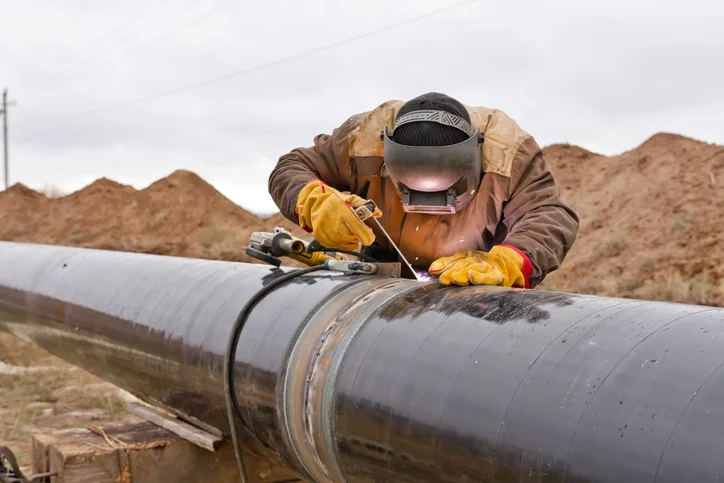Maximize Efficiency: Proactive Pipeline Welding Inspection Strategies
Maximize Efficiency: Proactive Pipeline Welding Inspection Strategies
Blog Article
Comprehensive Introduction of Pipeline Welding Examination Procedures
In the realm of pipeline building, making certain the integrity and safety and security of welded joints is critical. Pipe welding examination treatments play a vital function in assuring that welded links meet stringent industry standards and specifications. From careful pre-welding assessments to thorough post-weld analyses, a distinct examination process is essential for maintaining the structural soundness of pipes. Comprehending the intricacies of welding inspection treatments is not just a regulative requirement but likewise a fundamental aspect of promoting the reliability of these crucial infrastructures.
Pre-welding Evaluation Preparations
Before beginning the welding process, comprehensive pre-welding assessment preparations are important to make certain the integrity and top quality of the weld joint. These prep work involve a thorough examination of the materials to be bonded, the welding devices, and the workplace. First of all, the products should be evaluated for any type of defects, pollutants, or inconsistencies that might endanger the weld. This includes monitoring for correct material grades, measurements, and surface area conditions. Pipeline Welding Inspection. Additionally, the welding devices requires to be inspected to confirm that it remains in excellent functioning condition, adjusted appropriately, and suitable for the particular welding process. Any kind of issues with the equipment must be addressed without delay to protect against problems in the weld. The work environment must be evaluated for cleanliness, appropriate ventilation, and security steps to make sure a conducive setting for the welding operation. By conducting extensive pre-welding evaluation preparations, potential concerns can be identified and fixed beforehand, leading to premium and trusted weld joints.
Welding Procedure Credentials
Comprehensive pre-welding examination prep work lay the foundation for the important procedure of Welding Procedure Qualification, ensuring the honesty and quality of the weld joint. Welding Treatment Qualification (WPQ) is a crucial action in the welding procedure that involves screening and certifying welding procedures to assure they meet details standards and needs. The WPQ procedure usually consists of welding treatment spec growth, welding procedure qualification screening, and paperwork of the outcomes.
Throughout welding procedure spec growth, vital details such as the welding process, welding materials, joint design, and welding criteria are specified to develop an extensive treatment. Ultimately, welding procedure credentials testing is carried out to confirm the recommended procedure's stability. This screening frequently includes welding test discount coupons that undergo various mechanical and non-destructive examinations to analyze the weld's quality and adherence to the specified standards.
In-process Weld Evaluation
Throughout the welding process, in-process weld inspection plays a vital duty in ensuring the quality and honesty of the weld joint - Pipeline Welding Inspection. This sort of evaluation involves keeping track of the welding specifications, examining the weld bead formation, and finding any kind of prospective flaws or interruptions as they take place. By carrying out in-process weld assessments, welding operators can immediately deal with any type of issues that may arise, thereby preventing further problems and ensuring that the last weld fulfills the needed specs
Common techniques made use of for in-process weld evaluation consist of visual inspection, fluid penetrant testing, magnetic bit screening, ultrasonic screening, and radiographic screening. In general, in-process weld examination is vital for preserving the quality and dependability of welded pipelines.
Non-destructive Screening (NDT)
Non-destructive Screening (NDT) click this link is a vital approach employed in pipeline welding examination to assess the integrity of weld sites joints without triggering damages to the bonded structure. By using different NDT strategies, assessors can assess the quality of welds and recognize any kind of issues or interruptions that may compromise the structural strength of the pipe. Usual NDT approaches utilized in pipe welding inspection include Radiographic Testing (RT), Ultrasonic Testing (UT), Magnetic Particle Checking (MPT), Liquid Penetrant Screening (LPT), and Visual Testing (VT)
RT involves using X-rays or gamma rays to produce photos of the internal structure of the weld, enabling examiners to find flaws such as porosity, cracks, or incomplete fusion. UT uses high-frequency acoustic waves to spot defects below the surface area of the weld, using in-depth info about the size and area of defects. MPT and LPT are used to recognize surface-breaking flaws by using magnetic bits or penetrant liquids to the weld location. Furthermore, VT includes visual evaluation of welds to determine any noticeable flaws.
Post-weld Inspection and Paperwork

Documentation of post-weld assessment findings is important for maintaining quality control documents and ensuring conformity with industry requirements and regulations. In-depth records must consist of information about the examination techniques utilized, the location and nature of any type of issues located, and any rehabilitative activities taken - Pipeline Welding Inspection. Appropriate documents not only acts as a document of the weld's top quality however additionally aids in future maintenance and examination processes
Final Thought

In final thought, pipe welding examination treatments play a critical role in guaranteeing the high quality and stability of welds. Generally, adherence to correct examination protocols is essential to the success of pipeline welding jobs.
From precise pre-welding assessments to detailed post-weld evaluations, a well-defined assessment procedure is crucial for keeping the architectural strength of pipelines. By conducting in-process weld assessments, welding operators can promptly resolve any kind of problems that may occur, thus avoiding further defects and ensuring that the last weld satisfies the needed specifications.
Usual methods made use of for in-process weld examination include aesthetic assessment, liquid penetrant testing, magnetic particle screening, ultrasonic testing, and radiographic screening.Non-destructive Testing (NDT) is a crucial method used in pipeline welding inspection to analyze the stability of weld joints without causing damages to the welded framework. Post-weld assessment involves numerous methods to analyze the welds for problems, consisting of aesthetic inspection, color penetrant testing, magnetic particle screening, ultrasonic testing, and radiographic screening.
Report this page